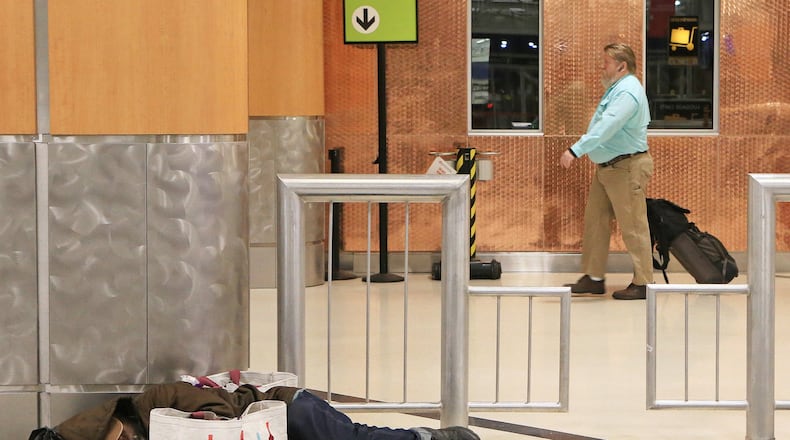The Atlanta City Council's proposed plan to help homeless people who were congregating in increasing numbers at the airport as the coronavirus surged has exposed gaps in coordination between MARTA and the city.
The city wants to provide services to the homeless at Hartsfield-Jackson International Airport to protect them and the public from contagion. It worked to move some of the homeless to housing and to clear others from the terminal and onto MARTA. But MARTA says that can result in them riding endlessly, sleeping on the trains and causing disturbances.
Despite their differences, some progress has been made in providing services and cutting the numbers of homeless people staying recently in the airport to a few dozen or less— it had swollen to as high as 300 on some days this spring. But many have just moved on to other parts of the city.
Two years ago, to keep the homeless from overnighting, the airport limited visitor access between 11 p.m. and 4:30 a.m to ticketed passengers, their companions and authorized personnel. It had some effect, but as cases of COVID-19 exploded in March and early April, and as temperatures turned cold, the homeless returned, leading to concerns about potential spread of the disease. Airport police became more stringent in enforcement to move them out.
“We can’t risk putting travelers in jeopardy of contracting COVID-19 because we’re not doing everything we can to ensure we’re protecting our residents and our unsheltered population,” said Atlanta city council member Antonio Brown, who spearheaded the city’s 60-day plan that passed last week. It proposes new services for the homeless and closing the airport earlier in the evening.
Brown said that would give the homeless more time to leave before MARTA stops operating each night, “so that they were not removed from the airport with nowhere to go.”
MARTA said the stricter enforcement and closing the airport earlier merely shifts the homeless to trains. When airport police escorted more than 100 homeless people into the terminal transit station one April night, MARTA police encountered them and others on trains riding without a destination, MARTA chief of staff Melissa Mullinax said in a letter to city council members. It says during the early phases of the COVID-19 pandemic, MARTA received increasing complaints about people “loitering, sleeping on trains for multiple trips and disturbances on the trains.”
“People are so quick to say what they don’t want, but you know, if an unsheltered passenger has a pass to get onto MARTA, they should be allowed onto MARTA, period,” Brown said.
Hartsfield-Jackson spokeswoman Elise Durham said the airport, which would make the call on changing operating hours, is “assessing the option.”
MARTA moved ahead with its own plan. It began removing homeless people from trains in April and is working with the nonprofit HOPE Atlanta, the airport’s homeless outreach contractor, working at a train station on the south end of downtown to connect the homeless with shelter or services.
The city also stepped up, contributing $1.5 million to house homeless people at high risk of COVID-19 in a hotel. City spokesman Michael Smith said coordination between agencies, nonprofits and shelters has helped to keep infection rates low and provide safe places for the homeless to quarantine.
Brown’s plan offers other services, but faces challenges, including lack of funding. It calls for testing for COVID-19 before the homeless at the airport are relocated to housing.
That’s tough, Brown said, because, “you need the rapid testing and the rapid testing in the city is very limited.”
The plan calls for on-site counseling at the airport.
“We’re working on obtaining the funding to do that,” said Brown, whose office has donated masks and gloves to distribute to the homeless at the airport.
Another constant challenge in providing help is that those who are coping with substance abuse and mental health issues often refuse to go to a shelter or hotel.
HOPE Atlanta’s executive director Jeff Smythe said he thinks some of the hundreds who used to sleep at the airport simply moved elsewhere.
“It’s certainly not feeling as chaotic and dangerous at the airport, but on the other hand, is it more chaotic and dangerous in other areas? Perhaps.”
About the Author
Keep Reading
The Latest
Featured


